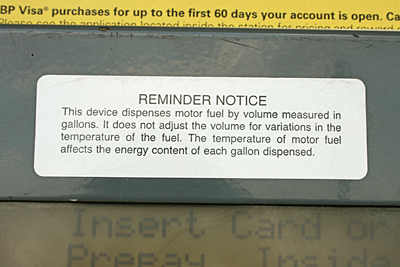During my recent drive between Illinois and North Carolina, I was pumping gas when I happened to see the following decal pasted on the face of the gas pump. The disclosure read like so much gobbledy-gook, as if purposely designed to be confusing or meaningless. It made me suspicious enough to snap a photo of it so that I could research it later:
I was astounded by what my research uncovered. According to a study undertaken by the Oversight and Government Reform Committee of the House of Representatives in June 2007, the oil industry has known for 100 years that gasoline expands with temperature. As it warms, gasoline expands by volume but not by weight or energy content. Since the 1920’s, the oil industry has adjusted wholesale transactions to a 60 degree Fahrenheit standard when measuring gasoline. But in most cases, the oil industry does not adjust for temperature in retail sales to consumers in the U.S. As a result, when the temperature of gasoline rises above 60 degrees, the amount of gasoline by weight decreases in a gallon, and the consumer is actually getting less fuel than they are paying for. This discrepancy has been dubbed the “hot fuel ripoff.”
Though technology exists to adjust the volume of gas being pumped according to the temperature, most U.S. retailers have not installed the gas nozzles that would resolve the problem. However, in the colder climate of Canada, the temperature of gasoline is often lower than 60 degrees. Since this would result in customers getting more than they’re paying for, Canadian gas stations have been fitted with a pump nozzle that measures the temperature of gasoline as it leaves the pump and automatically adjusts the volume dispensed.
In the U.S., the loss is perhaps 50 cents per hot tankful for individual motorists, but according to Federal data, the collective loss is about $450 million a year in California alone, and was estimated to be around $1.5 billion across the U.S. during the summer of 2007.
California, Texas, and Missouri are considering bills that would force retailers to install Automatic Temperature Compensation (ATC) pumps that would adjust the gallons sold for the 60 degree standard. Since the 1970’s, Hawaii has required retail pumps to dispense fuel on the assumption that the temperature of the gasoline is 80 degrees. As for the rest of the country, until laws are passed to rectify this latest corrupt practice of the oil industry, there are actions that we can take:
- Since all service station storage tanks are buried below ground, and the colder the ground, the denser the gasoline, fill up your car or truck in the morning when temperatures are cooler
- If a tanker truck is delivering gasoline to a station, buy your fuel elsewhere. Gasoline that comes from the refinery is hot, and the underground tank acts like a giant thermos bottle, retaining the heat for hours.
- Pray for the rapid development of cars with hydrogen fuel cells and hydrogen refilling stations

